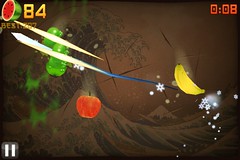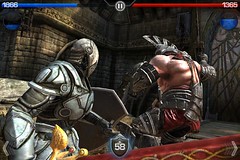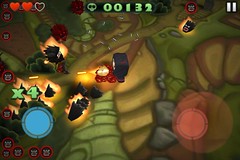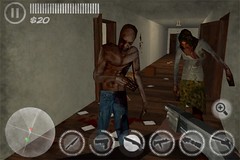Hooptie Utility Bike 2.0

I recently completed an overhaul of my primary ride. I replaced the original suspension fork with a sleek rigid fork better suited to the routes I ride. I also installed new brake calipers, for finer adjustment and modulation, as well as a pair of red-sidewalled winter tires, for sassy good looks. Learning about headset assembly was fun and rewarding!
Posted on Wednesday, February 23rd, 2011. Tags: bike.
Last Year’s Starfighters Are Today’s News
Here are a pair of LEGO starfighters I made last year.
These are both Vic Vipers, a popular design loosely based on the player ship from a classic video game. Vic Vipers are characterized by two forward prongs, two rear wings, and a single vertical tail fin. I’m not quite sure why they’re so popular in the LEGO-verse, but I think part of the reason is that the template provides a creative constraint, like painting with a limited palette or engineering on a budget.
Another creative constraint I like to employ when building models is to use pieces from only one or two sets. It helps you learn to see each piece as an elemental shape instead of a specific type of part with a fixed function. Draw what you see, not just a symbol for what you think you see.
Also, strive to rationalize your most indulgent hobby as a valuable exercise in mental elasticity.
Anyway, both ships were built in time for the annual “NoVVember” challenge. The second ship was built as a subtle but specific tribute to nnenn (Nate Nielson), a prolific and respected builder who died unexpectedly last year. The ship incorporates two instances of the funny quasi-part Nate used as his recognizable icon.
So what sort of creative constraints do you work with, intentionally or otherwise? Can a cage become a scaffolding?
Posted on Thursday, February 3rd, 2011. Tags: LEGO.
“Export to LDraw” plugin for Google SketchUp
As mentioned in my previous post, I recently drafted a new LDraw part in SketchUp. I converted that model to LDraw format with a script derived from su2ldraw. My version of the plugin is now available as ldraw_export.rb; you can get it here (now at GitHub). More details on installation and usage in the file itself.
Posted on Tuesday, February 1st, 2011. Tags: code, LDraw, LEGO, ruby, sketchup.
2011 (1)
Here is a progress report on some of my 2011 objectives, roughly a month in to the year. (But don’t expect this to become a regular thing. What do you think this is – some kind of blog?)
1. Running
Like a million other people, I went for a run on New Year’s Day.
Unlike most of them, I’ve continued running, in hardy defiance of the Dark and the Cold and the Wet. I ran in two January Freeze 10ks – my first races at the 10k length. As reported elsewhere, I even sustained minor flesh wounds in the second race. I’ll spare you photos, but it was rad.
Three weeks in, I got a cold. I took about a week off from running to let my damage repair crews immune system restore full respiratory function. Went back out for a jog today to shake the kinks out. Felt good to rev the jets up above idle again! A week off really sets you back, though.
Fitting a run into the daily schedule can be hard, especially in winter. For me, the hardest part is not coping with the cold or negotiating snowy paths (hell, that’s the fun part; see e.g. here) but just crossing the threshold from indoors to out. I find that focusing on getting outdoors by just putting on some running clothes before I’m entirely out of workday/errand mode helps make that happen. A little attitude helps, too. (“Yeah, it’s 16˚F out and I’m running. You’re not. I win.”)
What’s in store for this month? There’s a 5k coming up in a week or two I’d like to do. Otherwise, just get in the habit of running and work on a modest base to launch from once spring hits. My friend and running mentor Pre promises me it’s gonna be brutal.
2. Brick Blueprint
I enjoy fiddling with LEGO and LDraw software. Most of the models I build these days are built with pieces from specific sets. I started a Flickr group called LEGO Remix for these sort of creations, and it seems to have caught on. I’ve thought about combining these interests with a little modest capitalism for a few years. Now I’m going to give it a shot.
Brick Blueprint is the working name for an online store where you will be able to buy affordable high quality instructions for new models you can build with the LEGO sets you already have.
There are already some great sources out there for awesome custom models, such as Brickmania. Two things set Brick Blueprint apart, and will, I think, make it appealing to a broad market:
- The instructions are the only product. With no inventory of bricks to acquire, assort, or ship, low costs will result in low prices – on the order of a few dollars, rather than a few dozen or a few hundred.
- Cheap instructions are no use if you need a million bricks to build the model. By using the palette of parts available in existing sets, fans and parents can get instructions for new models that don’t require a huge collection or a separate part order.
There’s not much to report on the web site side of things, but a few pawns are in place. (Incidentally, the Brothers Brick posted an interview with four part resellers today – some of them full-time.)
If I’m going to design many models using parts from popular sets, I don’t want to be hung up by the absence of certain new or unusual parts in the LDraw part library. I’ll need to be able to draft them myself. Towards that end, I’ve modeled a newly-introduced canopy.
I used SketchUp to generate most of the shape, and a Ruby script based on Jim Foltz’ su2ldraw to export the SketchUp model to LDraw format. I intend to post my version of the script once I get a chance to clean it up a bit and add some more error handling.
More images documenting my part-authoring experiments are posted here. My canopy part is now in the library tracker and progressing towards certification. (That’s a lot of big talk for a digital model of a model toy, I know, but hey – geek cred where credit is due.)
3. Bicycles
Is announcing your intent to build something fun really much of a new year’s resolution? I guess this questions applies to objectives 2 and 3.
The goal of this project is to build a new bike for my stable. I already have a couple bikes, but I look forward to the process of picking out individual components and assembling a machine tailored for my needs and interests.
Earlier this week I was actually thinking about building two bikes – one city bike for errands and commuting, and one touring bike for trips and more recreational rides. Then I realized that duh, I already have a solid city bike. (Insert lesson about candy-shop greed here.)
A few repairs and additions (lighting and new brakes, for sure, and maybe a rebuilt/replaced rear hub) will bring the Schwinn up to the desired level of performance and reliability that lead me to think about a new city bike – for far less than the cost of a new bike. (When I say “city bike” I have the upright posture and relaxed handlebars of a cruiser in mind. It’s about comfort and everyday practicality.)
So, the new bike will fill the go-fast/go-far niche. It will be heavy by racing bike standards, but light and zippy compared to my cruiser or mountain-bike-hybrid-street-stomper. Its load-bearing capacity will rival the hybrid’s, with less of the Frankenstein’s monster look. Chances are good it will begin with a Nashbar touring frame, but I’ll have to have a look at some of the area bike shops that sell parts and used machines before committing to any components.
4. Occupation
SIGINT sources report low to no chatter on this channel.
Posted on Sunday, January 30th, 2011. Tags: bike, LDraw, running.
2011
- Philadelphia Marathon.
(Conditioning corollary: sub-5:00 mile, finally.) - Brick Blueprints, a hobby venture.
- Build a bicycle. Tour some more.
- Career transition.
Further details as events warrant.
Posted on Friday, December 31st, 2010. Tags: bike, LEGO, running.
Snow Slicks
I don’t need no stinkin’ knobbies! (This is on a closed seasonal access road where sweet tailslides are an acceptable substitute for controlled stops. Roads with cars are clear and dry – otherwise, yes, I’d be riding winter treads.)
Update: Wow! Mattracks for mountain bikes: KtraK!
Posted on Tuesday, December 28th, 2010. Tags: bike.
Five Apps I Like
Last weekend I reviewed some iPhone games. Here are some other apps I use, sans haikus. I am not including built-in apps such as Safari or Mail, nor am I listing every third-party app I’ve installed; presented here are just a few of my favorites. Title links go to the App Store.
Stanza
Stanza is a free ebook reader application by Lexcycle. I use Stanza mainly for reading the ePub editions of online short fiction magazines such as Lightspeed. Pictured above is the glossy “jukebox” view of cover art, but I typically browse my library in list view. You can group the listing by author or by user-defined collection, and you can sort each listing in various ways. The reading view is highly customizable (fonts, colors, margins – you name it) and the interface is fairly intuitive (tap left or right side to go back or forward, pinch to change size, press and hold to annotate or look up a definition). Somewhat to my surprise, I have become accustomed to reading white text on a black background – perhaps because it feels more comfortable when the iPhone is the only source of light. Turning on the “Display Styles” option under Layout settings helps preserve some importing formatting (such as distinct typefaces for questions and answers in interview transcripts).
Stanza plays nicely with Dropbox, also available for the iPhone, which makes it easy to keep your files in sync.
I would like if it was possible to perform a text search across the whole library, not just the current book.
PlainText
This is a useful plain text editor by Hog Bay Software. You can title notes and organize them in folders. It is tightly integrated with Dropbox, so any notes you take on the go are immediately available on your computer, too (and vice versa). It works without Dropbox, too (useful even if you do have account, because you still take and save notes without an active connection – syncing is just deferred until it gets a chance). Free; you can pay a couple bucks to remove the unobtrusive ads.
AutoStitch
There are a number of panoramic photo apps available. This is the one I have, and it’s great. Take a bunch of overlapping photos, select ’em, and “boom” – panorama. It’s easy, it’s fast, and it’s fun.
Poke around the company website – the people behind the program have some other interesting image processing projects, too.
Kinetic
The built-in Maps app is great, but Kinetic by Mothership is a nifty GPS logger for those occasions when you wonder “just how far is that ride” or “I wonder how fast I can bomb down that hill with a bike full of groceries”. You can customize the display with everything from signal strength to pace, but in my typical usage I just turn it on and pocket the phone (screen off) before hopping on my bike.
It’s fun to examine the logs. As you drag the progress marker along the bottom of the screen, corresponding markers on the map and speed/elevation graph show where you were and how you were moving at that point in your ride. I think there are some minor improvements that could boost the utility of the graph feature, such as a moving the value labels from the endpoints to the vicinity of the marker when zoomed in (at present, you can’t see the labels when zoomed in to look at the details of the graph).
Star Walk
What star or planet is that? Launch Star Walk, hold the phone up to the sky, adjust the brightness setting to approximate what’s actually visible, and tap the object in question to see its name and details. It’s a clever use of various sensors to simplify search based on where you are and where you’re looking. To be honest, I haven’t made many opportunities to consult it out under the night sky yet, but I think just playing around with it can help you learn where to look for things.
(For another example of the powerful convergence of sensors and portable processing mojo, check out Word Lens. I’ve tried the demo, which just reverses words instead of translating them – even so, given bright lighting, it’s space-age cool.)
Posted on Sunday, December 19th, 2010. Tags: iphone.
My Top Ten iPhone Games, Haiku Reviewed
I haven’t played many video games in recent years. I upgraded to a Mk. IV Apple Ansible this fall. For better or worse, the quantity of quality games available for iOS has since drawn me back into the fray. Here is a list of ten of my favorite iPhone games, sorted alphabetically by title, and reviewed in signature anoved.net haiku style. Title links take you to the App Store.
Chop Chop Soccer

Bobble-headed tots
compete beneath your fingers –
fakeout, flick, kick, score!
I like the simplicity of the controls and the art style of this fingertip futbol game. (Many sports games present a tedious amount of franchise or roster management – not so here.) If you’ve got the ball, you drag or swirl your finger on screen to dribble or fake out opponents. To pass or shoot, you just flick in the direction you want to kick. To try to steal the ball when playing defense, just flick towards it.
The screenshot about is taken with the “Action” camera mode, but I prefer the “Side” view because the orientation remains stable, keeping input simple.
Fruit Ninja

The Order of Chefs
is sworn to slice ripened fruit.
Swing your cleavers high!
It’s basically like Infinity Blade, except you’re slicing up food instead of ogres and assassins. I think the juicy exploding-fruit sound effects are my favorite part.
Infinity Blade

Weave your sword just so:
thrust and lunge, deflect, cut low.
The God King, the foe.
I feel that this swordfighting game lives up to the hype surrounding its recent release. Powered by the same Unreal Engine showcased in the free Epic Citadel, it’s no surprise that Infinity Blade’s graphics, artwork, and cinematography are top-notch.
Critically, the gameplay is engaging, too. You confront various enemies in a cyclical sequence of duels. (There’s no time wasted trotting about in search of fights, much to the dismay of some among the App Store commentariat. Another thing the comment kids don’t seem to get is that it’s not “over” once you reach or even beat the God King.) Your success, especially against more powerful foes, is reliant on the details of your technique. You can survive by swinging wildly, sometimes, but the real challenge – and reward – is in refining your stroke and footwork to maximize damage dealt while minimizing injuries received. It’s hard to put down – “just one more round!”
Some criticisms: the wheezes, screeches, and grunts uttered by the combatants do get a little tiresome (although my cat seems to like them). In the heat of battle, it can be frustrating when the dodge or block buttons don’t seem to do anything – but this is surely a matter of poor timing on my behalf, not any bug in the game.
Jet Car Stunts

Boost into the blue.
Extend flaps, float, drift and twist.
Rubber chirps, grips – go!
The set-up is zany – you drive a race car with airbrakes and rechargable JATO around geometrical platforms situated in the sky – but the controls are nearly perfect. Steady hands are required to stick the landing on long jumps, but a quick boost or skid will snap you back on track. Just as much a puzzle game as a racing game, Jet Car Stunts nevertheless elicits memories of Star Wars: Episode I Racer, my favorite racing game ever.
Minigore

Hikin’ in Hardland,
huntin’ furry lil buggers
who be huntin’ you.
Minigore is a frenetic “twin stick” arcade shooter that pitches you as hapless protagonist John Gore (or some other character) against unending swarms of fuzzy (and often firey) forest freaks. Individually, the monsters are easily dispatched – but in crowds, they’re overwhelming. Fortunately, your machine gun never runs out of bullets, and if you collect enough lucky charms, you can go nuts and trample the beasties as your own alter-ego beast.
The “twin stick” label refers to games with two [virtual] joysticks, one which controls your character’s movement and one which controls their direction of fire. In other words, you can aim and move in different directions at the same time.
N.Y. Zombies

Building lights are out.
Thump and stumble in the hall.
Pump and shoot ’em all.
There are many zombie survival games out there. This is the one I have. It can actually be quite frightening. I like it.
In each level your task is to stand your ground until the creeps stop coming. You have a small arsenal of weapons at your disposal, which can be upgraded or exchanged between levels. You don’t run out of ammunition, but the weapons do take a moment to reload. You can switch to a different weapon while one is reloading, but if you’re not careful you can sometimes find yourself without any ready to fire – and a few seconds may be all it takes for the zombies to get you.
I think much of the suspense comes from the fact that enemies approach from all directions. This imparts a wary feeling of needing to look over your shoulder, so although your character remains stationary, you must constantly turn back and forth to keep the undead at bay.
Rat On A Scooter XL

It’s Ratty! It’s Rat!
With helmet and Vespa and gas!
Go, Ratty, go and don’t splat!
Rat jumps his scooter from platform to platform collecting cheese. How far will he get before he falls? It’s up to you! There’s just one button: tap the screen to make him jump or, if he’s already airborne and he’s got the gas, to give him a little boost.
The scooter’s motor makes a delightful sputtering sound.
Real Racing

Hug the line, off gas,
nick the curb strip, whip the wheel,
and drop the hammer.
Lots of tracks, four car classes, and a brisk sense of speed make this a great driving game.
Control method B (tilt steering with gas and brake pedals, no brake assist) is the only acceptable input method. Accelerometer steering feels more realistic than any joystick, keyboard, or console controller I’ve used. Cockpit view is important, too. The exterior camera somehow makes the handling seem less convincing to me.
Reckless Racing

Back roads – good ol’ boys
gonna powerslide semis
down in the holler.
Top-down Hazzard county automotive mayhem. There’s a fun variety of cars and trucks to choose from, and detailed scenery to soak in as you gun your buggy through the mud and careen around the farmyard. I like the music.
Samurai II: Vengeance

Artful Eastern land
of lilies, cogs, and honor
wants not for lost blood.
There are nicely illustrated introductions to the chapters of this game, which is itself rendered in an attractive cel-shaded fashion. The “steampunk” feudal Japan setting provides an interesting and generally soothing environment in which to, um, slaughter lots of bad guys. I haven’t quite mastered the timing necessary to consistently pull off the “combo” attacks, so it’s definitely challenging – but that’s a good thing. Your progress is saved after clearing each section of the level, which makes it feasible to work your way through the game in small increments.
Words With Friends

Spell like you mean it –
not just any word will do.
Fear my triple Q.
Words With Friends is like Scrabble, albeit with a different board layout and automatic arbitration of what is and isn’t a valid word. I’m afraid I’m a junkie. My addiction is fed by the fact that you can play multiple games at once, asynchronously, so it’s almost always your turn. Plus, you can take as much time as you want to mull over your move.
Unfortunately, it is also somewhat buggy. The amount of time spent “Sending…” each turn seems disproportionate to the amount of data that must be transmitted. Worse, games occasionally appear to be corrupted and prematurely lost. A “Repairing…” message sometimes appears, but rarely succeeds in restoring these games.
So there you have it, my list of ten favorite iPhone games. Hey, I didn’t say it was a list of ten and only ten games.
In my opinion (<soapbox>as someone who doesn’t pirate software and who happily pays for good software from small shops</soapbox>), iPhone apps are incredibly cheap. Nevertheless, checking in on Touch Arcade once in a while is a fine way to see what games are temporarily free or on sale – I bought many of the games listed above at a discount. “Lite” versions of many games are also available.
No promises (blogs can’t handle commitment), but maybe I’ll review some of my favorite non-game apps, too.
Posted on Sunday, December 12th, 2010. Tags: games, iphone.
NaNoDrawMo 2010 Favorites
Here are a bunch of favorites from the 50 drawings I did for NaNoDrawMo this year.
This year also saw the debut of a new stupid human trick: drawing with my feet.
In other arts and crafts news, I made a monster mask out of newspaper and masking tape.
Posted on Saturday, November 27th, 2010. Tags: art, drawing.
Why I Ride
Because bringing groceries home in a car isn’t half as much fun!
That’s just one of many reasons. I was inspired to post something topical by all the wonderful entries in EcoVelo’s recent Why I Ride photo-essay contest. Take a few minutes to browse through the entries. Many of the photos and bicycles are attractive and interesting, but read the accompanying statements, too. Happiness and feelings of freedom are common themes.
Posted on Friday, November 5th, 2010. Tags: bike.























